As you lie back in your seat, the chair beneath you ascends — leading you ever closer to a sterile, silvery light. Inhaling the faint, lingering smells of antiseptic and peppermint, you shut your eyes and adjust the creases in your crinkling blue bib. No, you aren’t in line at the pearly gates. You’re in the dentist’s office, receiving essential care for your pearly whites.
For some, a dental cleaning might sound like heaven on Earth — restoring your mouth to mint condition may inspire and sense immense satisfaction. For many others, however, the mere thought of a dental visit sparks a descent into total anxiety (and, really, all that nail-biting can’t be good for your teeth).
Whether you’re an oral care enthusiast or a forgetful flosser, visiting Goodwin’s free Dental Hygiene Clinic will provide you with the comprehensive treatment you need to maintain a bright and blooming smile. And if you’re feeling a little iffy, don’t sweat it. Instead, let’s explore the experience through the eyes of a once-wary patient — me.
The dental dilemma
Dentists and oral care specialists have long advised that everybody —regardless of age and overall health — makes a habit of receiving biannual cleanings. Even if you brush and floss with the utmost fidelity, the recommendation to visit the dentist’s office every six months remains the same.
While this isn’t a secret, knowing this best practice doesn’t ensure we’re actually practicing it. In fact, over a third of Americans don’t even visit the dentist once a year, let alone twice. So, if we know that, in theory, we’re supposed to receive regular cleanings, why do so many of us maintain a cool distance from the dental chair?
Those avoiding their biannual cleanings are motivated by numerous factors: fear, financial constraints, inefficient insurance, and inflexible work schedules can all play roles in the equation. Moreover, for a few years in the early 2020s, dental care faced another constraint — the safety concerns surrounding the COVID-19 pandemic.
Say “bye” to stigma
If it’s been a hot minute since you upheld your end of the biannual bargain, don’t be ashamed. You’re certainly not alone. Take me, for example — from late 2019 to late 2023, I, too, did not receive a single cleaning. That’s eight appointments missed (or over 1,450 days without a cleaning, to be precise).
My reasons for skipping these sessions were not unlike those cited by other Americans avoiding the chair. First, it was the pandemic. Then, it was the double-bind between poor insurance and high expenses. Eventually, it became shame fueled by fear of judgment. What would a hygienist or dentist think if I sat in the chair and told them I spent four years shirking expert dental advice?
Here, the logical brain kicks in. Dentists and hygienists combat countless oral ailments and care for teeth in any condition. While your oral routine might not be perfect, like any other medical professional, these trained experts are there to help you get well. Keeping this in mind, I decided to book a dental cleaning without breaking the bank — scheduling a free cleaning at Goodwin University’s Dental Hygiene Clinic.
Scheduling my sessions
The first step of my Dental Clinic Journey was the most obvious (yet often the most nerve-racking) step: booking the appointment. Although you could call the Clinic, I preferred to use the online appointment request form. The process of doing so was fast and hassle-free.
Within a few hours, I received an email from the Dental Hygiene staff. They explained that the appointment would spread between two sessions. Although booking two timeslots is a more substantial commitment than your average dental appointment, the Clinic schedule is flexible. Day, evening, and Saturday appointments are available, so I selected one afternoon and one evening session. The nighttime availability was perfect for my work schedule, as I wouldn’t have to take additional time off to attend the second appointment.
Wondering what it’s like to work in the world of dental hygiene? At Goodwin, we have the comprehensive resources you need to jumpstart a rewarding career. Check out our free Dental Hygiene Get Started Guide and discover why Goodwin is the right school for you.
Arriving for my appointment
When I arrived at the Dental Hygiene Clinic on 403 Main Street, I couldn’t help feeling anxious about the time elapsed since my last visit. Holding back butterflies, I rang the bell and was buzzed into the building by security. After signing in with the guards on duty at the front desk, I was directed to an adjacent waiting room.
Located just a stone’s throw from the security desk, I walked into the Dental Clinic’s waiting area — a calm, relaxed space with a spacious seating arrangement (including a few play stations for children). I was welcomed by an amicable Dental Hygiene student, who helped me sign in and explained my designated hygienist, Christina, would come to get me shortly.
Meeting my hygienist
After waiting for a few brief minutes, Christina entered the waiting room. With a friendly greeting, she led me into the patient bay. Situated at the heart of the Dental Clinic, this epicenter was bustling with visiting patients and hardworking Dental Hygiene students — supervised by a seasoned professor, who circulated the room to assist and monitor the hygienists in training.
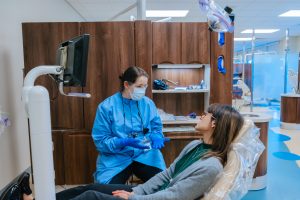
Christina led me to the section reserved for my appointment. Immediately impressed by her personable yet professional demeanor (not to mention anxious to alleviate the weight from my chest,) I quickly confessed it had been four years since my last cleaning. As wary as I was of sharing this, I was met with nothing short of total reassurance.
Intake and initial assessment
After settling in, Christina walked me through the technicalities of my visit. Typically, new patient appointments require an x-ray. However, I’d had a dental x-ray only a year earlier, so Christina and her professor were cautious of unnecessarily exposing me to more radiation. Consequently, they contacted the center holding my previous x-rays to request that they fax a copy to the clinic.
Proceeding with the initial phase of the appointment, Christina performed a comprehensive patient intake — covering everything from my vitals and respirations to my health history and prescriptions. I shared that I experience exercise-induced asthma, so to be safe, Christina asked me to keep my inhaler on hand during our sessions.
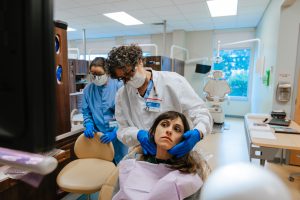
Once her professor authorized the intake, Christina proceeded with an oral cancer screening — something I had never received at previous dental visits. Next, performing a preliminary survey of my teeth, Christina looked for fillings, cavities, and other anomalies. Christina worked with keen eyes and a gentle touch — her confidence and competence put my remaining anxiety to rest. With one final review and an affirmation from her professor, Christina was ready to proceed with my periodontal assessment.
Looking through the loupes
While, initially, it seemed as though I didn’t have much damage despite the lapse since my last cleaning, a more accurate picture emerged once Christina performed my periodontal assessment. Meticulously using her loupes (the magnifying scopes worn by dental professionals), she examined my mouth for soft spots, decay, and other issues. In doing so, Christina gained an accurate understanding of my oral health.
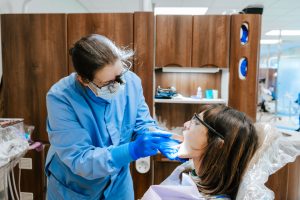
Marking her findings on my chart, Christina noted that I had some significant decay and calculus (or crystalized plaque) built up on my teeth and within the lining of my gums. After double-checking Christina’s work, her professor confirmed the accuracy of this assessment.
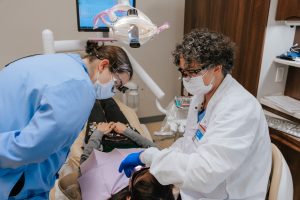
Then, it was time to perform the final step of my first appointment. Using a washable purple gel (which, I promise, comes off easily), Christina stained my teeth to reveal the areas with the most significant damage — extensively and thoroughly documenting her findings, all the while.
Thanks to the depth taken during this initial evaluation, Christina developed an understanding of the care I would need at my next appointment, at which point the cleaning would commence. While the existing decay is likely permanent, she reassured me that with a thorough dental cleaning, regular upkeep, and future diligence, we could stop the damage in its tracks — reducing the likelihood of additional issues down the road.
Coming back for my cleaning
I returned to the clinic a few days later, eager to get my teeth back in tip-top shape. After checking in for my appointment, Christina found me in the waiting room and, with a friendly “hello,” she took me back to the patient bay.
My second appointment started similarly to the first — Christina performed a comprehensive intake to ensure nothing had changed since my first visit. Her professor approved, and after a swift, 60-second swish of mouthwash, we were ready to begin.
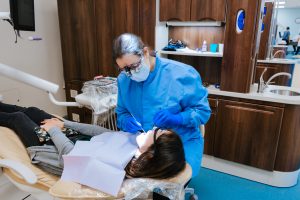
Preparing for polish
Now, for many people (definitely not me, though,) scaling and root planing is the most dreaded part of a dental cleaning. The sensation of the slight yet effectual metal tool traversing your teeth and gums — accompanied by quiet but discordant scraping sounds — can be a strange sensory experience.
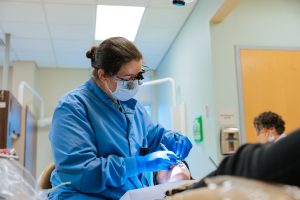
Diligently removing all plaque and calculus from each tooth, Christina used an ultrasonic scaler with mindful efficiency. The vibrating tool flushed water through my teeth and gums, removing the detrimental matter that had built up.
Having never experienced ultrasonic scaling, certain sections of my teeth were sensitive to the process. Christina was conscientious and communicative — checking in with me and occasionally administering numbing gel to reduce any soreness in my gums. When cleaning particularly delicate parts of my mouth, she switched to a manual scaler for a softer approach.
After carefully scraping each tooth, Christina summoned her professor. Confirming that she exercised expert precision, Christina’s professor approved — giving her the green light to proceed with polishing.
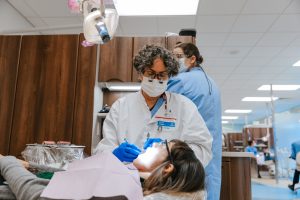
Finishing with fluoride
After Christina polished and flossed my teeth, it was time for the final step — fluoride. Having asked whether I used city or well water during my initial intake, Christina knew I did not have fluoride in my tap. While these treatments are commonplace during dental visits, she explained that my status as a well-water user made its application all the more pertinent.
After administering fluoride, Christina advised that I not eat crunchy foods or partake in my typical dental routine that evening; that way, the fluoride would have time to settle — fully reaping the benefits of the treatment.
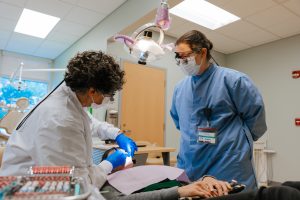
Recommending a new routine
Many dental visits end with an abrupt hand-off–a little plastic bag scantily filled with floss, a brush, and a travel-sized toothpaste. At the Clinic, however, my cleaning closed with deliberate, personalized counseling. Taking the time to offer tailored guidance, Christina advised that I toss my handheld toothbrush in favor of an electric one — even using a plastic jaw to model best practices for operating a battery-powered brush. She also recommended a fluoride-based mouthwash and provided pointers regarding the types of floss that will work best for my teeth (the spaces between which are particularly tight).
Aside from troubleshooting my newly optimized dental routine, Christina outlined the next steps for proactively pursuing preventative dental care. She identified a reputable provider local to my hometown — supplying me with a name, contact information, and address. Given the initial decay to my teeth and gums, Christina advised that I receive a cleaning every four months for the foreseeable future.
Because I’m known to clench my jaw while I sleep, Christina additionally encouraged me to inquire about a mouthguard at my new dental home. She reviewed the unique benefits of both guard types — explaining that while a hard, rigid guard offers better joint support, a soft guard protects your teeth from damage or fracturing.
A spotless smile
Exiting the Clinic, I smoothed my tongue against the back of my teeth — for four years, the satisfaction of a pristine smile was never fully realized. With my journey to the Goodwin Clinic complete, I can earnestly attest to receiving the most thorough dental care of my decade-spanning days. In addition to garnering a new appreciation for quality dental care, I left rejuvenated in my determination to maintain a healthy mouth. As Christina explained, dental care doesn’t live on an island — a part of your body, like all the rest, your teeth stand intricately linked to your big-picture well-being.
Interested in embarking on a fulfilling career as a dental hygienist? At Goodwin University, you’ll gain the knowledge and skills necessary to provide comprehensive and compassionate care to diverse patients from all walks of life. Learn more about enrolling in our Dental Hygiene program today! Call 800-889-3282 or text 860-467-1511.
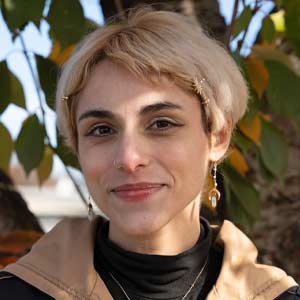
Bri Gagné is a marketing content writer at Goodwin University, bringing backgrounds in literary studies, creative storytelling, Universal Design for Learning (UDL), and social justice. They earned their bachelor’s degree in English Literature and Film Studies from University of Connecticut and a master’s in education from Eastern Connecticut State University.
After teaching English abroad and locally, Bri transitioned to a full-time writing career, contributing to the University’s educational narratives and brand-building efforts. They plan to begin their Master of Fine Arts in creative writing in 2025.

